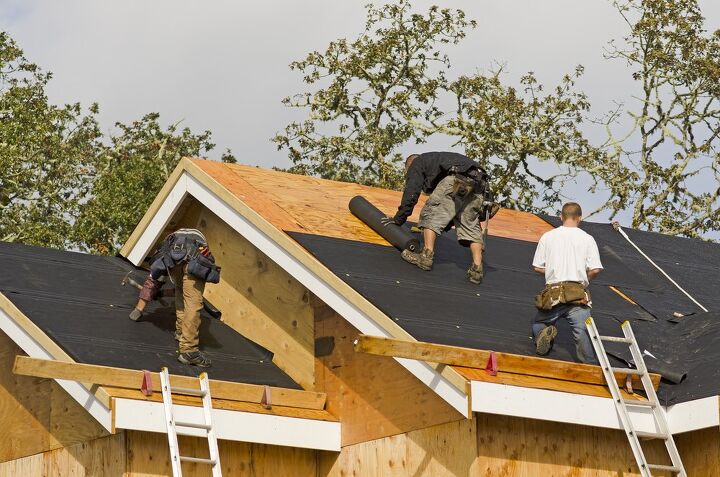Does The Drip Edge Go Under Tar Paper?

Many homeowners may never experience having to replace the roof on their homes. If you are like me and live in an area prone to high winds and large hailstorms, roof replacement is a fact of life. Many people don’t realize that a roof is a complex system of layers that protect your home. Many homeowners raise one question: Does the drip edge go under or over the tar paper?
The International Building Code specifies that drip edge shall be provided at the eaves and rake edges of shingle roofs. On the eaves, the underlayment shall be installed over the drip edges. On rake edges, the underlayment shall be installed under the drip edge. The IBC also specifies the width, joint construction, and fastening of the drip edge.
There are sound construction principles behind these regulations. You should understand how your roof system works to protect your home from the elements. There are different types of drip edge to consider and the placement of the drip edge in relation to the underlayment for the shingles. Understanding how your roof system works make maintaining and inspecting your roof easier and more efficient.
Do You Need Roofing, Siding, or Gutter Installers?
Get free, zero-commitment quotes from pro contractors near you.

What is a Drip Edge?
Drip edge is a metal flashing installed along the eaves and rakes of your home. This metal flashing keeps rainwater from getting under your roofing components and from damaging the fascia of your home. Properly installed drip edge prevents wind-driven rain, snow, and ice from penetrating the shingles and underlayment.
The surface tension of water can often pull water back under the edge of shingles and underlayment. Drip edge is designed to help prevent this water intrusion. A drip edge also help direct rainwater into your gutters to prevent damage to the eaves, overhangs, and fascia of your home.,
What are the Types of Drip Edge?
Drip Edge flashing comes in three basic configurations. Unfortunately, there is no standard naming scheme for these different drip edges. You may hear different names in different parts of the country. The easiest way to tell the different drip edge types apart is by the profile of the flashing.
- Type C Flashing – The profile of Type C flashing is a classic L shape. C flashing is bent at a 90-degree angle near the middle of the flashing, while the lower edge has a flange.
- Type D Flashing – Type D metal flashing is a misnomer. The profile of type D flashing is shaped more like a T. Type D, or T-style flashing is the preferred drip edge style by the Asphalt Roofing Manufacturers Association. D-style flashing keeps water further away from the fascia in most cases.
- Type F Flashing – If you install a new drip edge over an existing roof, Type F flashing is usually used. Type F flashing has a longer leading edge than other styles of drip edge.
These are the three most common styles of drip edge used on roofing construction in the United States. Other styles may be found in home improvement centers. These other styles have different uses and are not used when installing a shingle roof.
Why Is Drip Edge Installed Differently on Eaves and Rakes?
First, you must understand the difference between an eave and a rake edge. Eave edges run along the lower edge of the roof. Generally, the eave overhangs your house’s exterior wall, providing space under the eave. This space, called a soffit, prevents rainwater from running off the roof and directly down the exterior siding of your home.
The rake edge begins at the roof’s peak and runs down along the gable where it meets the eave or terminates in a valley in the roof. Rake edges typically have the same overhang as the eave edge to protect the gable and siding of your home.
Water typically runs off an eave edge. The IBC calls for the drip edge flashing to be placed under the underlayment of your roof. This is an added protection in case water penetrates the shingles. This water will run down the underlayment and be shed from the roof. If the drip edge were over the underlayment, water could run under the drip edge flashing and damage the decking or fascia of your home.
On the gable ends, water tends not to run off the edge. However, these exposed edges are more prone to wind-blown water or wind damage than eave edges. Placing the drip edge flashing over the underlayment helps prevent water from getting under the underlayment material. The drip edge also helps prevent high winds from lifting the underlayment and shingles.
Are Drip Edges Required on a Roof?
The International Building Code mandates drip edge on all shingle roofs. The IBC is the model building code for construction around the world. However, local jurisdictions that adopt the IBC model building code often add variations or additional requirements to the local building codes. Some jurisdictions exempt certain parts of the IBC model codes.
The only sure way to know if drip edge is required in your community is to check with the local building codes office. The building inspectors and enforcement personnel can tell you what is required by the local code in simple terms.
Can I Reuse the Drip Edge that is on My Roof Now?
You should generally replace the old drip edge when a new roof is installed. Most building codes prohibit the use of used materials when replacing a roof. You certainly wouldn’t want used shingles or underlayment.
The drip edge may look in good shape but removing the old underlayment and shingles often damages the drip edge. Placing the new underlayment under the rake edges means removing the drip edge flashing. It is often more economical to put on a new drip edge than try and salvage the old material.
The Shingles on My New Roof overhang the Drip Edge. Is This Correct?
Shingles should overhang the drip edge on the eave of your roof. It is customary to cut the shingles flush with the drip edge on the rake. There are several good reasons for these installation practices.
Shingles on the eave edge of your roof should overhang the drip edge flashing about one-half to three-quarters of an inch. This provides an extra margin of safety for your roof. The shingle overhang helps prevent water from seeping back under the shingles. If you have gutters on the eaves of your home, this overhang helps prevent water from getting between the gutter and the fascia of your home.
On the rake of your roof, cutting the shingles flush with the drip edge helps protect the roof from wind. An overhang on the rake could allow the shingles to lift in a strong wind and damage the roofing material.
What is Tar Paper and Why is it Used Under Shingles
Tar paper is an asphalt-impregnated paper product. Tar paper is a waterproofing material that has been used for many years under shingle roofs to provide an extra layer of protection. Often called felt by roofers, this product can be purchased in 15 or 30-pound weights. 30 lb. tar paper has more asphalt than 15 lb. tar paper and provides more protection.
Your roof is a system of components designed to protect your home and keep water from entering during rain. The base of your roof is the decking. This material may be plywood, oriented strand board or particleboard.
The underlayment is the next layer. Tar paper was used exclusively for many years. However, the development of lighter and cheaper materials for underlayments has made the use of tar paper rare. Most roofing contractors now use these waterproof manmade underlayment materials.
The shingles are the final layer on the roof system. Most shingles are attached to the roof decking using nails or staples. Many people wonder about the nails penetrating the underlayment and allowing water to enter the home. Old-timers maintain that the asphalt in tar paper helped prevent this by sealing nail holes as the weather gets hotter. Modern underlayment materials don’t perform this function.
What is the Best Material for Drip Edge Flashing?
Drip edge flashing is typically made from galvanized steel or aluminum. You can purchase drip edge made from copper, but the cost is almost prohibitive. The International Building Code doesn’t distinguish between galvanized and aluminum drip edges.
Aluminum has several advantages. Aluminum drip edge is lighter than galvanized steel and doesn’t rust. However, the aluminum drip edge is not as strong as steel and tends to bend easily.
Galvanized steel is much stronger than aluminum drip edge. Many contractors consider galvanized steel a better option than aluminum for drip edges. Unfortunately, steel also rusts. The galvanizing process protects much of the steel drip edge except where nails penetrate the metal. These penetrations can become starter spots for rust that destroy the drip edge.
Do You Need Roofing, Siding, or Gutter Installers?
Get free, zero-commitment quotes from pro contractors near you.

Where to Put the Drip Edge: Under of Over the Underlayment?
Your local building code is the controlling authority about installing a drip edge on a roof. Absent a building code in your area, the accepted method is to put the tar paper under the drip edge on the rakes and over the drip edge on the eaves. Consult with your roofing contractor about their methods of installing drip edges before starting a roofing project.

Dennis is a retired firefighter with an extensive background in construction, home improvement, and remodeling. He worked in the trades part-time while serving as an active firefighter. On his retirement, he started a remodeling and home repair business, which he ran for several years.
More by Dennis Howard














![10 Best Cordless Leaf Blowers – [2022 Reviews & Ultimate Guide]](https://cdn-fastly.upgradedhome.com/media/2023/07/31/9070789/10-best-cordless-leaf-blowers-2022-reviews-ultimate-guide.jpg?size=350x220)












